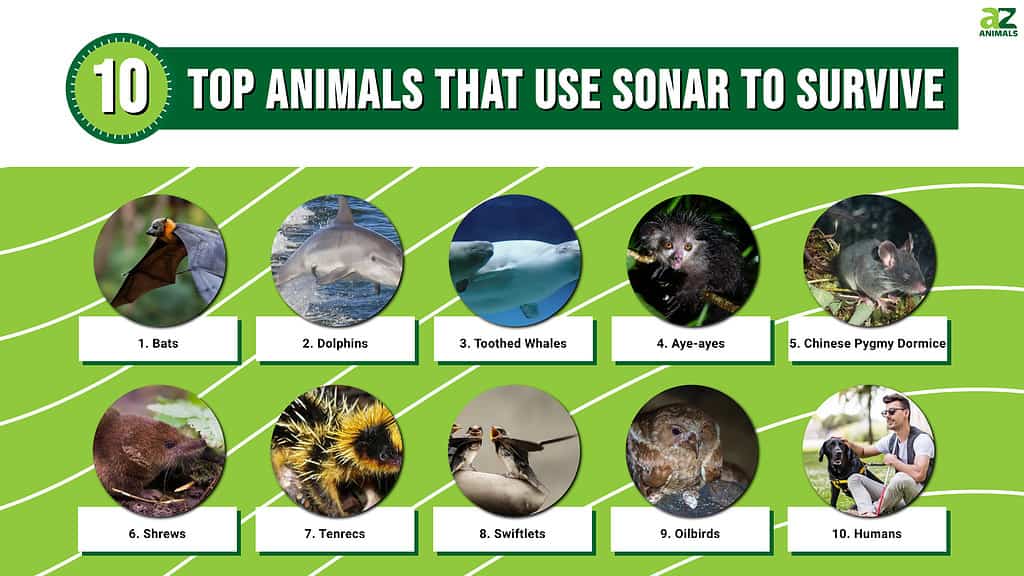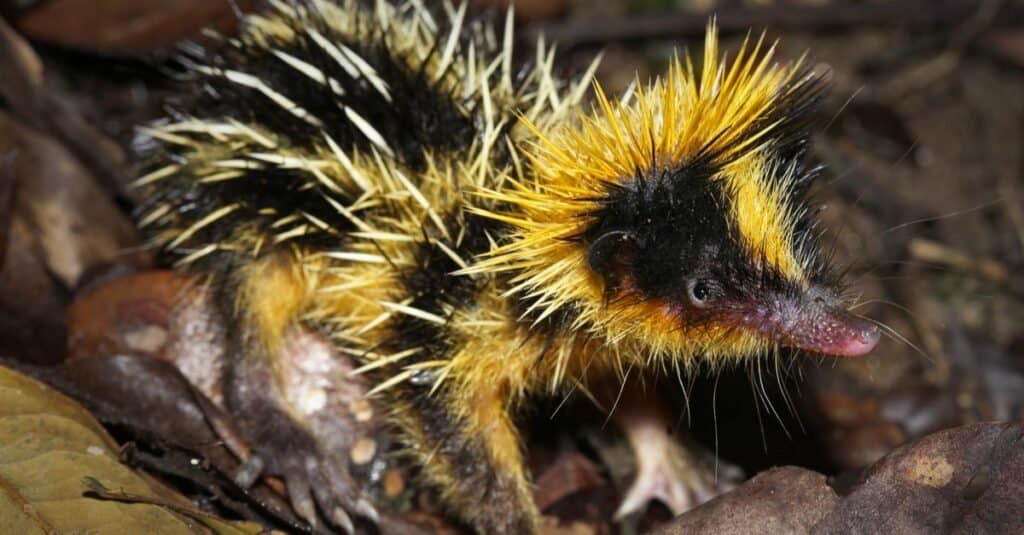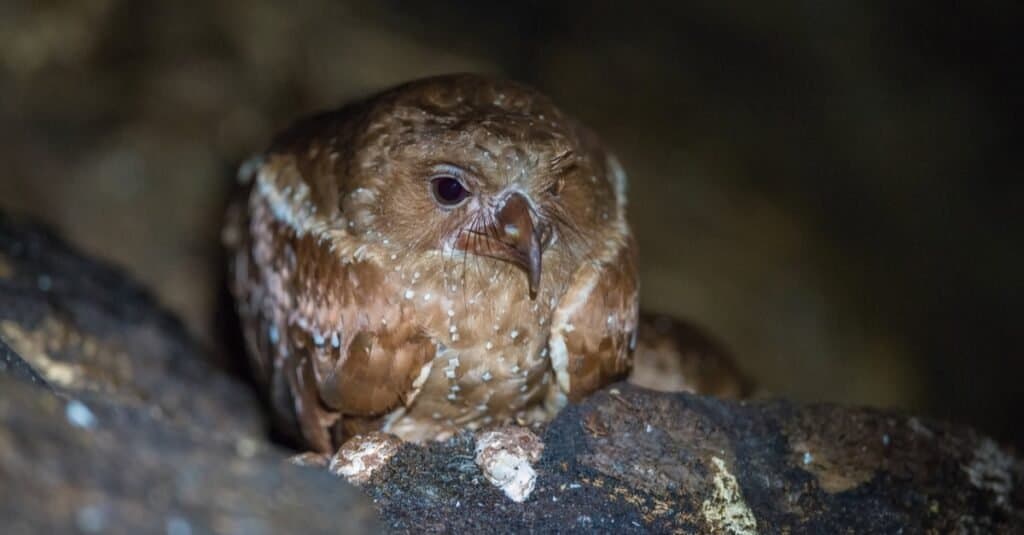- They are also able to tell the material objects are made from.
- Dolphins’ skill in this regard has made it possible for them to play a key role in detecting underwater mines.

Sonar or SONAR is an acronym for the words “SOund Navigation And Ranging.” It allows an animal (or a man-made device like a submarine) to use sound waves – specifically, sound propagation – to detect objects, navigate, measure distances, or even communicate.
In animals, this ability is described as biosonar or echolocation. How does sonar work? Think of the word “echo” in “echolocation.” The animal produces a sound that echoes or bounces off of objects. The animal can interpret the echo or returning sound to determine the shape, material, and distance of the object it bounced off of.
Why is sonar vital for some animals’ survival? Various animals use sonar to find their way in the dark, locate food, or avoid predators. These animals often use sonar in the place of other senses, such as sight or smell. Without echolocation, these animals would not survive for long. They would not be able to find food, or they would be eaten by a predator or injure themselves by flying or swimming into solid objects.
What animals use echolocation for survival? Many people are familiar with the sonar used by bats and dolphins, but would you believe that some rodents and birds use it too? Check out our full list below – no. 10 might surprise you!
1. Bats

©iStock.com/phototrip
Bats emit loud clicks as they fly. When the sound reaches an insect in flight or a physical obstacle, it bounces back to the bat’s ears. Specialized regions of the brain decode the sounds, and the back is able to hunt its prey or fly around obstructions.
Have you ever heard the adage “blind as a bat”? It is true that some bats are nearly blind, and these species certainly rely on echolocation in place of the sense of sight. But a number of sighted bats utilize echolocation as well.
Not all species of bats use echolocation, however. Those in the suborders Microchiroptera and Megachiroptera use sonar for hunting and navigation, respectively. But fruit bats such as flying foxes do not use echolocation at all.
2. Dolphins

©Tory Kallman/Shutterstock.com
Dolphins are well-known for their high-pitched noises and clicks. The dolphins make these noises in the nasal sacs and focus the sound waves through the melon, the bulb of fatty tissue in the dolphin’s head.
Water is an excellent sound conductor; therefore, these noises bounce off of objects and return to the dolphin. Dolphins can use echolocation to find fish in murky water or objects buried in the sand. Scientists have determined that a bottlenose dolphin (Tursiops truncatus) can “hear” an item the size of a ping-pong ball from more than 350 feet away!
Dolphins can also use echolocation to determine what an item is made of. For example, they are often interested in medical devices (metal pins and rods, artificial limbs) or scar tissue when interacting with humans. Decades ago, some dolphins were even trained as underwater “spies” for the military! Their jobs included locating lost objects (using their sonar) and looking for underwater mines.
3. Toothed Whales

©CampCrazy Photography/Shutterstock.com
Toothed whales such as orcas (Orcinus orca), sperm whales (Physeter macrocephalus), porpoises, and beluga whales (Delphinapterus leucas) use echolocation in a manner similar to dolphins. Dolphins, discussed above, are also toothed whales.
Toothed whales use echolocation to navigate in murky water with low visibility. They also use it to find prey. Belugas were among the first whales theorized to use sonar, based on observations of their swimming and navigation. Interestingly, the sperm whale uses single sonar clicks, while other species use a series of clicks called click trains.
Baleen whales, such as blue whales (Balaenoptera musculus) and humpback (Megaptera novaeangliae) whales do not use echolocation.
4. Aye-ayes

©Eugen Haag/Shutterstock.com
The aye-aye (Daubentonia madagascariensis)is a bizarre-looking type of lemur native to Madagascar. It is the only non-human primate known to use echolocation. And they do not employ clicks or vocalizations. Instead, the aye-aye taps on the tree in which it climbs using a long, thin middle finger. It then listens for the echoes coming from within the tree. What it hears tells it whether insect burrows are present. If they are, it digs in!
5. Chinese Pygmy Dormice

©Alexei V. Abramov / CC BY – License
The Chinese pygmy dormouse (Typhlomys cinereus) is an arboreal or tree-dwelling rodent that is nearly blind. It uses soft squeaks too quiet for human ears to hear to navigate tree branches. It is thought that this unique quality – soft rather than loud noises – is due to the fact that the branches are very close to the animal. Its echoes do not have to span the distances as those of other sonar users.
6.Shrews

©iStock.com/CreativeNature_nl
Shrews are small mammals similar to moles. They resemble rodents but are not classified as such. At least three species of the shrew – common shrew (Sorex araneus), the wandering shrew (Sorex vagrans), and the short-tailed shrew (Blarina brevicauda) – have been observed using echolocation. Others may also have this ability.
Instead of clicks, shrews call out with ultrasonic squeaks. Like our other sonar users, they then listen to the echoes to explore dark environments.
7. Tenrecs

©Ryan M. Bolton/Shutterstock.com
Have you ever heard of a tenrec? This small mammal from Madagascar resembles the shrew or hedgehog. There are about thirty species of tenrecs, ranging in size from a few ounces to two pounds.
Tenrecs use tongue clicks for echolocation. It is thought that they use this sonar as a means of finding food. Interestingly, tenrec echolocation seems to be instinctive; it is not a learned behavior. Even captive-raised tenrecs kept in isolation use sonar to explore their enclosures.
8. Aerodamus Cave Swiftlets

©Wang LiQiang/Shutterstock.com
Swiftlets are small birds that live in caves throughout Asia and the Pacific. Life can get pretty crowded for these birds that live in flocks of up to a million individuals. How do they avoid bumping into one another while flying in dark caves? Some species, such as the pygmy swiftlet (Collocalia troglodytes) emit clicks that allow them to navigate via sonar.
Cave swiftlets are one of only two birds known to use sonar. Consider the other below.
9. Oilbirds

©Petr Simon/Shutterstock.com
Oilbirds (Steatornis caripensis) are native to South America. Their name comes from the plump appearance of their young. Like the swiftlet, oilbirds are nocturnal and use echolocation to navigate their dark caves.
10. Humans

©iStock.com/Halfpoint
Above, we mentioned how humans (Homo sapiens) have created machines that use sonar. Submarines and aircraft may use it to navigate. Commercial and recreational fishermen use it to find fish, and researchers use it to map the floor of the ocean.
But some humans have mastered the fascinating ability of biosonar. When a person loses their eyesight and becomes blind, or when they are born blind, other senses may become heightened to compensate. Some blind people listen carefully to their environments to help them get around. A few even make short, high clicks and listen to the echoes.
Animals That Use Sonar
What other animals might we discover that covertly use sonar for survival? Only time will tell. Experiments with blind rats indicate that they may be able to learn to use sonar to navigate mazes. There may be others capable of such learned behavior, or those that use noises too low for us to hear.
Summary of Top 10 Animals That Use Sonar to Survive
Here’s a summary of the top 10 animals that use sonar:
| Rank | Animal |
|---|---|
| 1. | Bat |
| 2. | Dolphin |
| 3. | Toothed Whales |
| 4. | Aye-Ayes |
| 5. | Dormice |
| 6. | Shrews |
| 7. | Tenrecs |
| 8. | Swiftlets |
| 9. | Oilbirds |
| 10. | Humans |
The photo featured at the top of this post is © Alexander Baumann/Shutterstock.com
Thank you for reading! Have some feedback for us? Contact the AZ Animals editorial team.






